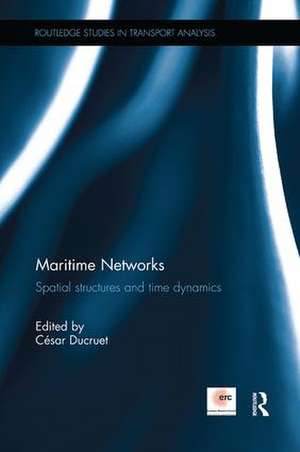Maritime Networks: Spatial structures and time dynamics: Routledge Studies in Transport Analysis
Editat de César Ducrueten Limba Engleză Paperback – 27 apr 2018
With contributions from reputable scholars from all over the world, this book investigates the analysis of maritime flows and networks from diverse disciplinary angles going across archaeology, history, geography, regional science, economics, mathematics, physics, and computer sciences. Based on a vast array of methods, such as Geographical Information Systems (GIS), spatial analysis, complex networks, modelling, and simulation, it addresses several crucial issues related with port hierarchy; route density; modal interdependency; network robustness and vulnerability; traffic concentration and seasonality; technological change and urban/regional economic development. This book examines new evidence about how socio-economic trends are reflected (but also influenced) by maritime flows and networks, and about the way this knowledge can support and enhance decision-making in relation to the development of ports, supply chains, and transport networks in general.
This book is an ideal companion to anyone interested in the network analysis of transport systems and economic systems in general, as well as the effective ways to analyse large datasets to answer complex issues in transportation and socio-economic development.
| Toate formatele și edițiile | Preț | Express |
|---|---|---|
| Paperback (1) | 422.00 lei 43-57 zile | |
| Taylor & Francis – 27 apr 2018 | 422.00 lei 43-57 zile | |
| Hardback (1) | 1172.34 lei 43-57 zile | |
| Taylor & Francis – 9 oct 2015 | 1172.34 lei 43-57 zile |
Din seria Routledge Studies in Transport Analysis
-
 Preț: 334.09 lei
Preț: 334.09 lei -
 Preț: 309.99 lei
Preț: 309.99 lei -
 Preț: 290.57 lei
Preț: 290.57 lei - 18%
 Preț: 260.13 lei
Preț: 260.13 lei - 17%
 Preț: 256.85 lei
Preț: 256.85 lei - 17%
 Preț: 259.98 lei
Preț: 259.98 lei -
 Preț: 425.86 lei
Preț: 425.86 lei - 17%
 Preț: 258.59 lei
Preț: 258.59 lei -
 Preț: 390.63 lei
Preț: 390.63 lei -
 Preț: 389.66 lei
Preț: 389.66 lei -
 Preț: 389.66 lei
Preț: 389.66 lei -
 Preț: 389.66 lei
Preț: 389.66 lei - 17%
 Preț: 259.98 lei
Preț: 259.98 lei - 16%
 Preț: 248.41 lei
Preț: 248.41 lei -
 Preț: 382.32 lei
Preț: 382.32 lei -
 Preț: 387.16 lei
Preț: 387.16 lei - 18%
 Preț: 1013.39 lei
Preț: 1013.39 lei - 18%
 Preț: 1008.17 lei
Preț: 1008.17 lei - 9%
 Preț: 1004.87 lei
Preț: 1004.87 lei - 9%
 Preț: 936.45 lei
Preț: 936.45 lei
Preț: 422.00 lei
Nou
Puncte Express: 633
Preț estimativ în valută:
80.75€ • 84.52$ • 67.21£
80.75€ • 84.52$ • 67.21£
Carte tipărită la comandă
Livrare economică 31 martie-14 aprilie
Preluare comenzi: 021 569.72.76
Specificații
ISBN-13: 9781138599307
ISBN-10: 1138599301
Pagini: 408
Ilustrații: 160 Line drawings, black and white; 44 Tables, black and white; 160 Illustrations, black and white
Dimensiuni: 156 x 234 x 21 mm
Greutate: 0.59 kg
Ediția:1
Editura: Taylor & Francis
Colecția Routledge
Seria Routledge Studies in Transport Analysis
Locul publicării:Oxford, United Kingdom
ISBN-10: 1138599301
Pagini: 408
Ilustrații: 160 Line drawings, black and white; 44 Tables, black and white; 160 Illustrations, black and white
Dimensiuni: 156 x 234 x 21 mm
Greutate: 0.59 kg
Ediția:1
Editura: Taylor & Francis
Colecția Routledge
Seria Routledge Studies in Transport Analysis
Locul publicării:Oxford, United Kingdom
Public țintă
Postgraduate and UndergraduateCuprins
Section I. Introduction to maritime network analysis Chapter 1. Maritime flows and networks in a multidisciplinary perspective Chapter 2. City-systems and maritime transport in the long term Chapter 3. A geohistory of maritime networks since 1945: the case of the Compagnie Générale Transatlantique’s transformation into CMA-CGM Chapter 4. Spatial networks: tools and perspectives Section II. Modelling past maritime networks Chapter 5. From oar to sail: the role of technology and geography in the evolution of Bronze Age Mediterranean networks Chapter 6. Venetian maritime supremacy through time. A visualisation experiment Chapter 7. Navigocorpus database and eighteenth-century French world maritime networks Chapter 8. British and Japanese shipping networks in China in the 1920s Chapter 9. Maritime shifts in the contemporary world economy: evidence from the Lloyd’s List corpus, 18th-21st centuries Section III Topology and spatial distribution of maritime networks Chapter 10. Time considerations for the study of complex maritime networks Chapter 11. Maritime networks monitoring, from position sensors to shipping patterns Chapter 12. Cluster identification in maritime flows with stochastic methods Chapter 13. Vulnerability and resilience of ports and maritime networks to cascading failures and targeted attacks Chapter 14. The distribution functions of vessel calls and port connectivity in the global cargo ship network Section IV Maritime networks and regional development Chapter 15. Impact of the emergence of direct shipping lines on port flows Chapter 16. The mutual specialisation of port regions connected by multiple commodity flows in a maritime network Chapter 17. Explaining international trade flows with shipping-based distances Chapter 18. Interplay between maritime and land modes in a system of cities Chapter 19. The regionalisation of maritime networks: evidence from a comparative analysis of maritime basins Chapter 20. Co-evolutionary dynamics of ports and cities in the global maritime network, 1950-1990
Descriere
With contributions from reputable scholars from all over the world, this book investigates the analysis of maritime flows and networks from diverse disciplinary angles going across archaeology, history, geography, regional science, economics, mathematics, physics, and computer sciences. Based on a vast array of methods, such as Geographical Information Systems (GIS), spatial analysis, complex networks, modelling, and simulation, it addresses several crucial issues related with port hierarchy; route density; modal interdependency; network robustness and vulnerability; traffic concentration and seasonality; technological change and urban/regional economic development. This book examines new evidence about how socio-economic trends are reflected (but also influenced) by maritime flows and networks, and about the way this knowledge can support and enhance decision-making in relation to the development of ports, supply chains, and transport networks in general.








